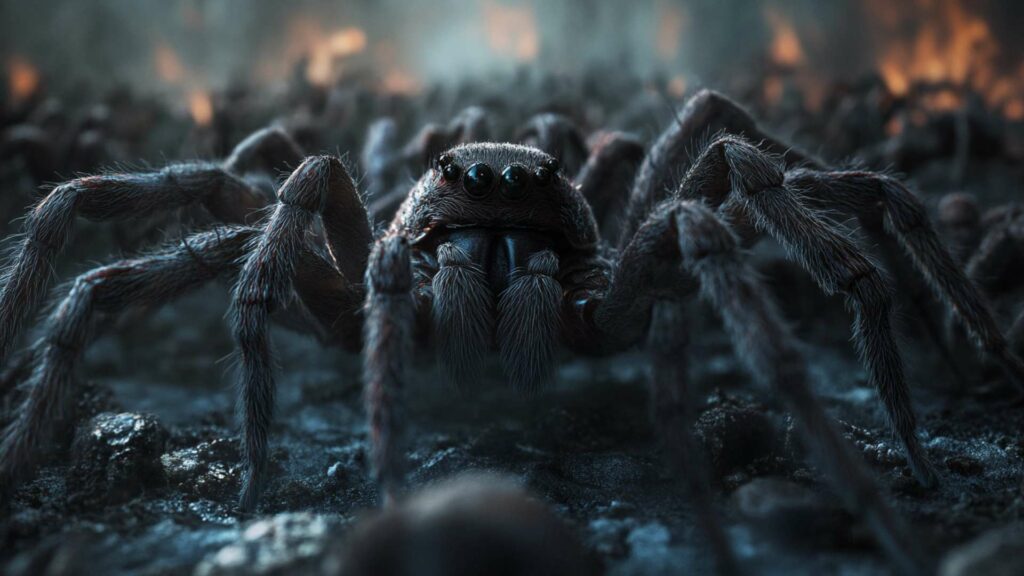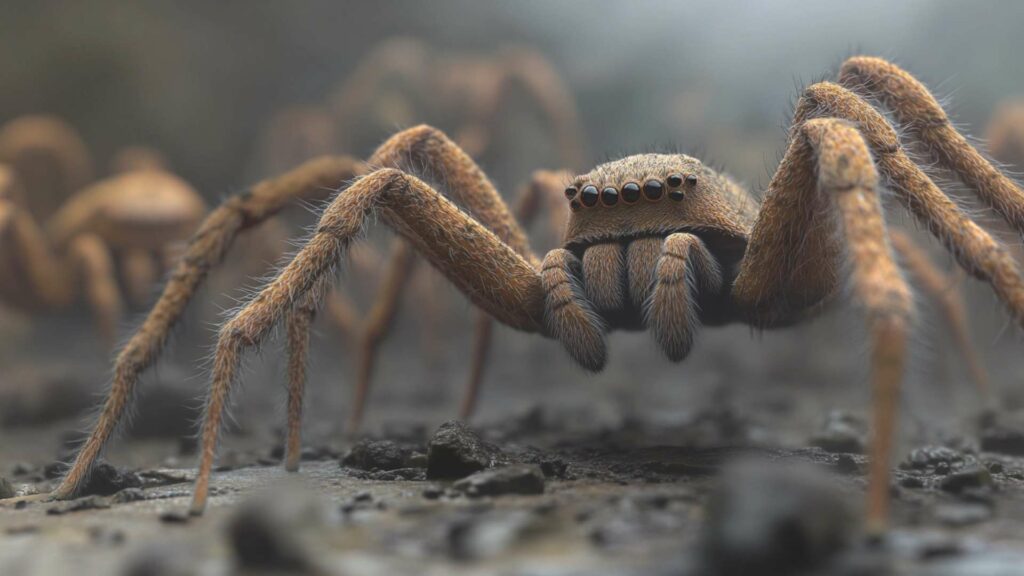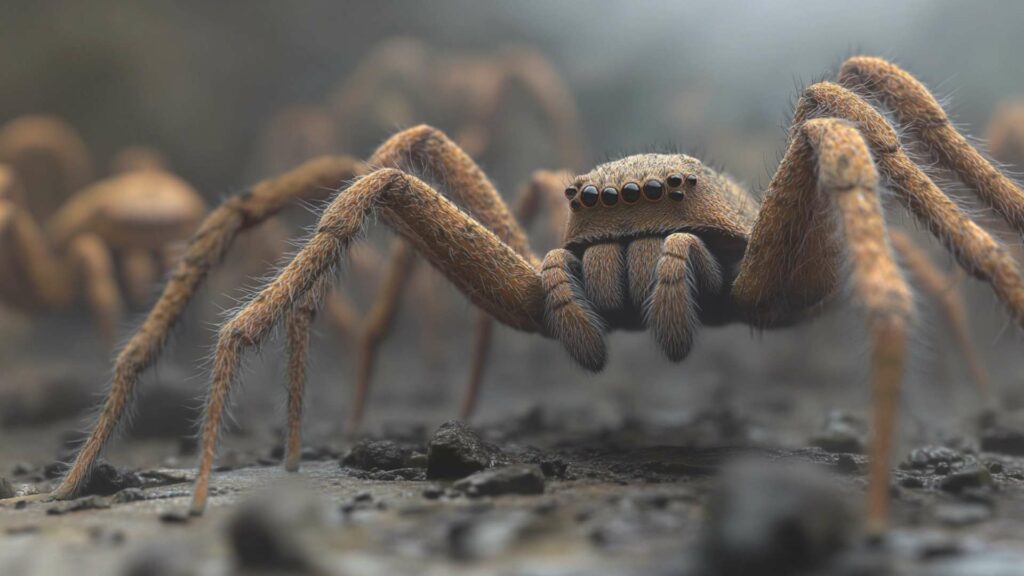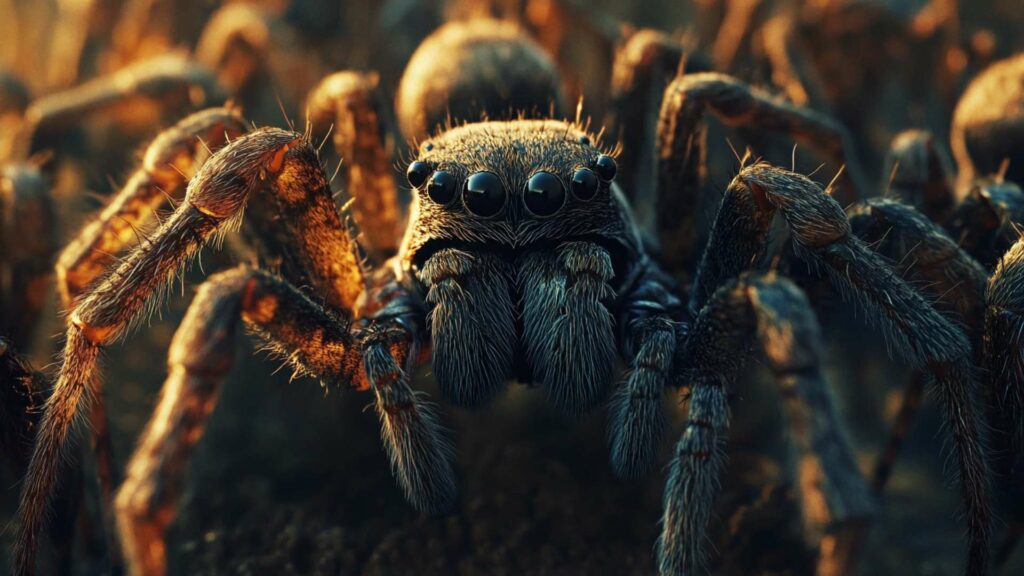A Bug’s Life: Spiders and Bed Bugs Unveiled
Picture this: a tiny, eight-legged arachnid stealthily lurking in the corners of your room. Meanwhile, in the shadows, an infamous bloodsucking pest is on the prowl. Yes, we’re talking about spiders and bed bugs.
These two creatures may be small in size but carry significant implications for our daily lives. Today, we embark on an enthralling quest to unravel the mysteries surrounding their potential interactions.
Spiders and bed bugs are just two members of a vast ecosystem teeming with diverse life forms. While spiders belong to the class Arachnida, most other bed bugs are wingless insects classified under Hemiptera.
Each species has its unique traits and adaptations that have evolved over millions of years. Spiders are renowned for their silk-spinning abilities and predator instincts, while bed bugs have gained notoriety as nighttime nuisances feasting on human blood.
The Enigma Unveiled: Do Spiders Consume Bed Bugs?

Now here’s where things start to get intriguing – do spiders actually eat bed bugs? The thought of these tiny arachnids preying upon those pesky pests might sound like a dream come true for anyone tormented by a bed bug infestation. But is it really possible?
Well, let’s delve into this enigmatic question and find out if these eight-legged hunters can indeed provide us with some much-needed respite from the relentless torment caused by these bloodthirsty invaders. As it turns out, almost all spider species possess a predatory nature when it comes to hunting insects that share their habitat.
While some spiders specialize in hunting ground-dwelling creatures like ants or roaches (which also happen to eat bed bugs), others have developed a taste for smaller prey such as mosquitoes or flies. However, when it comes to bed bugs, their status as natural predators is less clear-cut.
While some spiders have been observed feeding on bed bugs in controlled laboratory settings, it remains uncertain how frequently such interactions occur in the wild. So, hang on tight as we embark on a thrilling journey to uncover the truth behind the spider-bed bug relationship.
From masked bed bug hunters to voracious predators lurking in the darkness, we’ll explore the potential benefits these natural predators might offer in our ongoing battle against these notorious bloodsuckers. Prepare yourself for a captivating exploration that will leave you itching for more knowledge about these fascinating creatures.
Spiders: Nature’s Pest Controllers

Spider species are known for consuming insects
When it comes to feasting on insects, spiders are some of nature’s most skilled predators. While not all spider species actively pursue and consume insects, there are several that have earned a reputation as formidable hunters. Among them are common house spiders, jumping spiders, and wolf spiders.
Common house spiders (e.g., cellar spiders, cobweb spiders)

Common house spiders encompass a wide range of species that can be found in homes across the globe. Two popular members of this group are cellar spiders (also known as daddy longlegs or, crab walking spiders) and cobweb spiders.
These arachnids spin intricate webs in corners or dark areas where flies and other small insects often get trapped. Once ensnared in the web, the unsuspecting prey becomes a delectable meal for the patient spider.
Cellar spiders, with their long legs and delicate bodies, excel at capturing mosquitoes and flies that fly close to their webs. Cobweb spiders create tangled masses of silk that resemble messy cobwebs – hence their name – which provide an effective trap for various bugs that venture too close.
Jumping Spiders

Jumping spiders are incredibly agile hunters equipped with exceptional eyesight. Unlike most other spider families, these little acrobats do not rely solely on passively waiting for prey to fall into their webs. Instead, they actively hunt down their victims by stalking them with astonishing precision.
With impressive jumping abilities – some can leap up to 50 times their body length – these small but mighty predators pounce on unsuspecting insects like flies or moths from a distance. Jumping spiders plan their attack carefully before launching themselves towards the prey with lightning-fast movements.
Wolf Spiders

Wolf spiders belong to a family of ground-dwelling spiders known for their keen hunting skills. They do not spin intricate webs like their web-building relatives but rely on their excellent eyesight to spot prey in the vicinity.
Instead of weaving traps, they actively chase their victims, often running them down. With impressive speed and agility, wolf spiders can cover considerable ground in search of insects to devour.
Their diet includes a wide range of small creatures, from ants and beetles to other spider species. These natural predators contribute to maintaining the balance in ecosystems by keeping insect populations in check.
Spider feeding habits and prey preferences
Spiders exhibit diverse feeding habits and display preferences for certain types of prey. While some species mainly consume flying insects like mosquitoes and flies, others might prefer crawling bugs such as ants or beetles. Some species even specialize in hunting specific pests like bed bugs.
It’s essential to note that not all spider species consume bed bugs directly. However, spiders that eliminate bed bugs play a vital role in the natural ecosystem by controlling pest populations indirectly.
By targeting smaller insects that serve as potential food sources for bed bugs (such as moths or other moth larvae), spiders limit the availability of resources needed for bed bug survival and reproduction. Spiders showcase remarkable predation techniques and diverse feeding habits.
From common house spiders that patiently wait for trapped insects to jumping spiders that pounce on their prey with impressive precision, these arachnids have evolved an array of strategies to secure their next meal. While not all spider species directly hunt and eat bedbugs regularly other bugs, they contribute significantly to pest control by targeting other insects that indirectly impact the bed bug population and assist in maintaining a balanced ecosystem within our homes and surroundings.
Bed Bugs: Pesky Bloodsuckers

The Mysterious Cimex lectularius
Ah, bed bugs, those elusive little creatures that have plagued humans for centuries. Let’s dive into the basics of these bloodsucking pests and uncover some intriguing facts about Cimex lectularius, the notorious bed bug species. Bed bugs are small insects, about the size of an apple seed when fully grown.
They are oval in shape and have a reddish-brown color that allows them to blend seamlessly with their surroundings. These crafty critters are masters of hiding in cracks and crevices, making it incredibly challenging to spot them with the naked eye.
The Impact on Human Health

Bed bug infestations can cause a host of health issues for those unlucky enough to experience their presence. First and foremost, let’s address the bites – those itchy red welts that can appear on your skin after a bed bug-feeding frenzy. Although bed bugs are not known to transmit diseases directly through their bites, they can cause intense itching and discomfort.
Scratching these bites excessively may lead to secondary infections or allergic reactions in some individuals. Beyond the physical ailments caused by their bites, bed bugs can also take a toll on mental health.
The psychological impact of living with a bed bug infestation cannot be underestimated. Sleepless nights filled with anxiety about being bitten again become all too common for victims of these unwelcome houseguests.
The stress and frustration caused by ongoing infestations often lead to feelings of helplessness and even social isolation. Now, let us unravel more secrets surrounding the encounter between spiders and these tiny bloodsuckers as we delve into Section IV: Spider vs Bed Bug: The Ultimate Showdown!
Spider vs Bed Bug: The Ultimate Showdown!
Can spiders actually eat bed bugs?
Bed bugs, those pesky bloodsuckers that infest our homes, are certainly not appetizing to us humans. But when it comes to the kingdom of arachnids, spiders often prove to be voracious predators capable of devouring a wide range of unwanted pests.
So, can spiders eat dead bed bugs too? The answer is a resounding yes!
Size comparison between the two creatures
When we compare the size of spiders and bed bugs, it becomes evident that these two creatures are not evenly matched. While adult bed bugs typically measure only about 4-5 millimeters in length, spiders come in various sizes and shapes. From small house spiders like cellar spiders or cobweb spiders to larger species like wolf spiders or jumping spiders, many spider species are capable of preying on bed bugs effortlessly.
Spider venom and its effect on bed bugs
Apart from their size advantage, certain spider species possess venom that helps them overcome their prey’s defenses effectively. For instance, crab spiders and yellow sac spiders have venomous bites that can immobilize small insects such as bed bugs. Once bitten by these skilled hunters, the venom takes effect and paralyzes the unsuspecting prey before becoming a meal for the spider.
Observational evidence of spider predation on bed bugs
While scientific studies specifically focusing on spider predation on bed bugs may be limited, there is ample observational evidence suggesting that some spider species do indeed consume these bothersome pests. In homes or areas with known infestations where both bed bugs and suitable spider habitats coexist, homeowners have reported finding dead or partially consumed bed bug carcasses caught in spider webs. It’s important to note that while some types of house spiders and other spider species eat bed bugs regularly, spiders alone may not be sufficient to eliminate a bed bug infestation entirely.
However, their presence can certainly help in reducing the population of these bloodthirsty intruders. So, the next time you come across a spider in your bedroom, don’t be too quick to reach for the shoe – that spider might just be one of nature’s little helpers in keeping bed bugs at bay!
Factors Influencing Spider-Bed Bug Interactions

Environmental Conditions Favoring Spider Presence in Infested Areas
Spiders are highly adaptable creatures that can thrive in a variety of environments. When it comes to infested areas, certain environmental conditions tend to attract spiders, increasing the likelihood of their presence. Temperature, humidity, and light preferences vary among different spider species, influencing their habitat selection.
Temperature plays a significant role in spider activity. Many common house spiders prefer moderate temperatures between 70-80 degrees Fahrenheit (21-27 degrees Celsius).
Wolf spiders are known to tolerate cooler temperatures and can be active even in colder climates. Similarly, humidity levels impact spider behavior.
Some species thrive in higher humidity environments, while others adapt well to drier conditions. Light preferences also influence where spiders choose to establish themselves.
While most spiders prefer dimly lit or dark areas, some species are drawn to well-lit spaces where their preferred prey may be abundant. For example, running crab spiders have been observed near outdoor light fixtures that attract various insects at night.
Common Hiding Spots for Both Spiders and Bed Bugs
Both spiders and bed bugs seek out similar hiding spots within infested areas. Understanding these common hiding spots can shed light on the potential interactions between them.
Cracks, crevices, and furniture gaps provide ideal shelter for both spiders and bed bugs alike. These tiny spaces create secluded retreats where they can rest undisturbed during the day and emerge at night to hunt or feed respectively.
Mattresses, box springs, and headboards are particularly attractive hiding spots for bed bugs due to their proximity to human hosts. In addition to furniture-related hiding spots, other locations favored by both spiders and bed bugs include behind wallpaper or electrical outlets.
The thin gaps found behind wallpaper provide perfect cover for these small creatures as they move around discreetly. Electrical outlets, with their small openings and hidden spaces behind the wall cavity, offer additional refuge.
Availability of Alternative Prey for the Spider Population
The presence of alternative prey can also influence spider-bed bug interactions. Spiders are opportunistic predators that will consume various insects if available, affecting their inclination to actively hunt bed bugs.
In infested areas with diverse insect populations, spiders may have access to alternative prey that satisfies their dietary needs. For instance, house centipedes (known bed bug predators themselves) and other insect species like cockroaches readily seek out environments where they find bed bugs or similar food sources.
Moreover, ants, both as individuals and collectively as an ant colony, feed on a range of insects including bed bugs. However, it should be noted that some spider species exhibit a strong preference for eating bed bugs, over other prey items due to factors such as size or nutritional content.
Juvenile masked hunter bugs and assassin bugs are two examples of spiders that specifically target and eradicate bed bugs, bug eggs, and nymphs. These specialized predators play a crucial role in regulating bedbug populations when conditions allow for successful encounters.
Several factors influence the interaction between spiders and bed bugs in infested areas. Environmental conditions such as temperature, humidity, and light preferences affect spider presence and control bedbug populations.
Common hiding spots shared by both creatures include cracks, crevices, furniture gaps, mattresses, box springs, and headboards as well as behind wallpaper or electrical outlets. Furthermore,
Potential Benefits of Spiders Controlling Bed Bugs
Natural Pest Control without Chemical Intervention
Picture a world where pests are kept in check without the need for harmful chemicals or pesticides. This is precisely what spiders offer when it comes to controlling bed bug populations.
Spiders, as natural predators, have been honing their hunting skills for millions of years. They are exquisitely adapted to seek out and consume a range of insects, including bed bugs.
Their predatory instinct and ability to camouflage themselves make them efficient pest controllers. Unlike chemical treatments that can be toxic to humans and pets, spiders provide a balanced and environmentally friendly solution for managing bed bugs.
Through their innate ability to eat bed bugs regularly, spiders can naturally regulate infestations without causing harm to our health or the environment. By encouraging the presence of spider populations in our homes, we can harness their potential as the most experienced pest eradicator nature has to offer.
Reducing the Risk of Allergic Reactions Caused by Bed Bug Bites
Bed bug bites can cause discomfort and distress for those unfortunate enough to encounter these bloodsucking pests. Not only are the bites itchy and irritating, but some individuals may also experience allergic reactions that range from mild irritation to severe swelling or even anaphylaxis in rare cases. Here is where spiders become unlikely heroes: by preying on bed bugs, they help reduce the risk of repeated bites and subsequent allergic reactions.
Spiders act as a natural barrier between us and these irritating pests by controlling their population. With fewer bed bugs around, there is less chance of encountering them during restful sleep or while going about our daily activities.
So next time you spot a spider scuttling across your floor or nestled in its intricately spun web near your bedroom window, remember that it may be doing more than just spinning silk. It could be a stealthy protector, diligently working to control bed bugs and ensure a more peaceful and bite-free existence for us all.
Conclusion: Nature’s Pest Control at Work
It is fascinating to explore the intricate relationship between spiders and bed bugs. Spiders, known as nature’s pest controllers, play an important role in keeping the population of bed bugs in check.
While not all spider species consume bed bugs, there are several specific types that have been observed feasting on these pesky bloodsuckers. Through their impressive hunting techniques and venomous bites, spiders are natural predators that can effectively kill bed bugs.
They possess an innate ability to detect and capture these tiny pests, which is especially useful in infested areas where bed bug populations can rapidly multiply if left unchecked. However, we must keep in mind that spiders alone cannot fully control a bed bug infestation.
Factors such as environmental conditions and the availability of alternative prey also influence the prevalence of both spiders and bed bugs within a given area. Therefore, relying solely on spider predation may not be sufficient for complete eradication of these unwanted guests.
Optimistically speaking, encouraging the presence of natural predators like spiders can be an effective strategy to control bed bug populations without resorting to chemical intervention. By reducing the number of live bed bugs through spider predation, we can potentially lower the incidence of allergic reactions caused by their bites.
In nature’s intricate web of interactions, we find creatures like masked hunter bugs or running crab spiders hunting down their prey with precision while painted meal moths flutter by seeking refuge from spider silk traps. It is this delicate balance between predator and prey that allows us to witness the wonders of natural pest control firsthand.
So next time you come across a spider scurrying along your wall or ceiling, take a moment to appreciate its potential role as one of nature’s unsung heroes in keeping our homes free from bothersome intruders like bed bugs. Embrace the elegance with which they stalk their prey and devour it—the circle of life where even the tiniest creatures play a significant part.
Master the challenge of spiders with D-Termination: The top choice for Pest Control in Las Vegas!

Are spiders causing concern on your Las Vegas property? Look no further than D-Termination for the solution. Our skilled team specializes in eradicating spider infestations, bringing back a sense of peace and tranquility to your environment. Bid farewell to spiders—opt for D-Termination’s efficient pest control today!
Reach out to us at 702-919-6310 or visit dtermination.com to schedule your spider control service and take back your space from these bothersome pests.
Frequently Asked Questions:
Bed bugs don’t have significant natural predators.
Certain spiders, like the house spider, might consume bed bugs.
Some insects, such as certain beetles, feed on bed bugs.
Bed bugs are attracted to warmth, carbon dioxide, and human scent, often entering homes through infested items or luggage.







